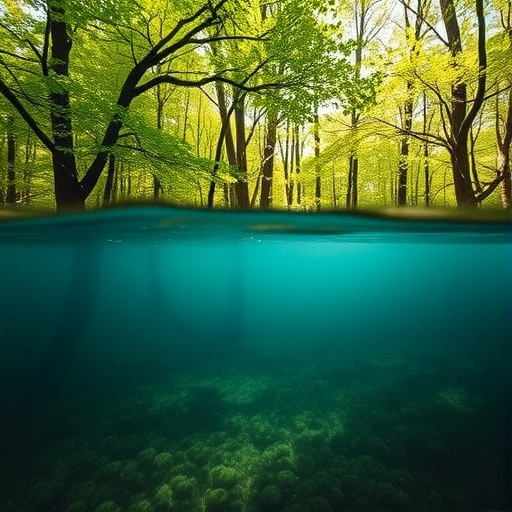In a groundbreaking study published in the “Environmental Science and Pollution Research,” a team of researchers delves deep into the dynamics of dissolved inorganic carbon (DIC) within the Godavari Estuary in India. This significant body of water, rich in biodiversity and vital ecological functions, serves as a case study for understanding how seasonal variations influence the sources and fluxes of carbon in estuarine environments. Through the innovative application of stable carbon isotopes, the researchers have unveiled complex interactions that may have profound implications for both local ecosystems and global carbon cycling.
The Godavari Estuary is not just a geographical feature; it is a vital ecological and economic hub for the communities that depend on it. As one of the largest rivers in India, the Godavari’s estuarine systems are intricately linked to various biogeochemical processes. These processes govern the transformation and transport of elements critical for marine life and the health of coastal regions. Previously, research has focused on separate variables affecting DIC concentrations; however, this study aims to integrate those variables through a multifaceted approach.
Utilizing high-resolution sampling protocols, the researchers collected water samples from various locations within the estuary, paying particular attention to seasonal changes. They employed state-of-the-art stable isotope analysis to trace the origins of DIC, illuminating how fresh water input from the river upstream mixes with saline waters as it flows toward the sea. This methodology allows for the differentiation of carbon sources—whether they originate from riverine inputs, biological processes such as respiration and decomposition, or the atmospheric deposition of CO2.
One of the remarkable findings of the study was the stark contrast in DIC sources between the wet and dry seasons. During the wet season, heavy rains greatly enhance the river’s discharge, bringing significant amounts of terrestrial organic carbon into the estuary. In this scenario, carbon derived from soils and vegetation predominantly drives the DIC concentrations. Conversely, during the dry season, the water levels drop, and the saline influence of seawater becomes more pronounced, leading to a shift in DIC sources predominantly derived from oceanic inputs. Understanding these temporal shifts is crucial for predicting how climate change and human activities could alter carbon dynamics in this sensitive environment.
The research team highlighted the role of biological processes in modifying DIC beyond mere dilution with freshwater. Microbial respiration and organic matter decomposition were significant contributors to elevated DIC levels, particularly during the dry months. The seasonal availability of light also affected photosynthetic activity, which takes up carbon, in turn influencing overall DIC concentrations. This complex interplay demonstrates how tightly linked the carbon cycle is to seasonal ecological events.
An unexpected revelation was the potential anthropogenic influence on DIC dynamics within the estuary. The study noted that urban run-off and agricultural activities introduced substantial nitrogen and phosphorus loads that could stimulate algal blooms. These blooms, while potentially beneficial at certain levels, can lead to hypoxic conditions that limit the availability of oxygen in the water. Such hypoxic zones further complicate the carbon dynamics by adding layers of stress to the aquatic life and altering the natural carbon cycling processes.
Further, the researchers emphasized the implications of their findings for local fisheries and the surrounding communities. The health of the estuarine ecosystem directly impacts the livelihoods of fishing communities that rely on these waters for their income. Continuous monitoring and understanding of DIC sources could lead to more effective management strategies that balance ecological health with economic needs.
As policymakers begin to realize the importance of estuarine systems in global carbon budgets, the insights presented in this research are timely. The results contribute significantly to the growing body of literature that underscores the relevance of estuaries in mitigating climate change impacts. They pose critical questions about how different management practices could improve the resilience of these ecosystems in the face of increasing human pressures and a changing climate.
In the broader context, the implications extend beyond the Godavari Estuary alone. Similar studies conducted in other estuarine environments could reliably inform global models of carbon cycling. By understanding how localized changes reflect global patterns, it becomes increasingly feasible to formulate more effective international climate policies and strategies aimed at carbon sequestration.
Furthermore, as researchers endeavor to disseminate their findings, collaboration among academic institutions, governmental bodies, and local communities will be paramount. Strategies that invoke citizen science could also play a significant role in broadening the scope of data collection and monitoring, ensuring an inclusive approach to ecosystem management.
Lastly, as climate change looms large over the globe, understanding DIC dynamics is a critical avenue for research that could yield solutions and adaptations necessary for the survival of estuarine and coastal systems. This study not only exemplifies the importance of scientific inquiry but also acts as a clarion call for proactive measures in the conservation and sustainable management of one of nature’s most productive ecosystems.
The researchers’ commitment to unveiling the intricacies of carbon dynamics in the Godavari Estuary sets a benchmark for future studies that aspire to understand the delicate balance within these complex ecosystems. With their pioneering methods and significant insights, they have opened up avenues for further exploration in the realm of environmental science—one with pressing relevance in today’s world.
Subject of Research: Seasonal variations in sources of dissolved inorganic carbon in the Godavari Estuary.
Article Title: Seasonal variations in sources of dissolved inorganic carbon in the Godavari Estuary (India) using stable carbon isotopes.
Article References:
Sreevidhya, R., Ghosh, V.R.D., Kumar, B.S.K. et al. Seasonal variations in sources of dissolved inorganic carbon in the Godavari estuary (India) using stable carbon isotopes.Environ Sci Pollut Res (2025). https://doi.org/10.1007/s11356-025-36944-w
Image Credits: AI Generated
DOI:
Keywords: Dissolved Inorganic Carbon, Godavari Estuary, Stable Carbon Isotopes, Seasonal Variation, Carbon Cycling.




